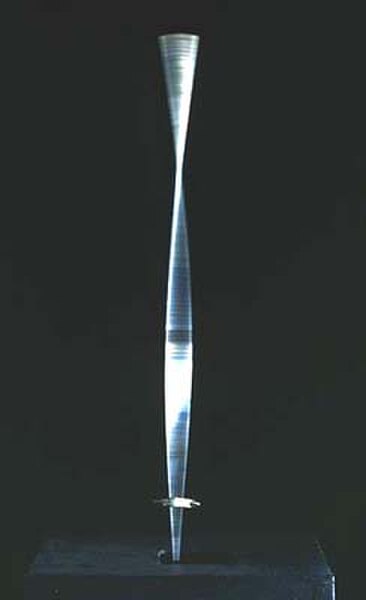Phyllis Mark was an American modern artist. She was a leading proponent of kinetic sculpture, rotating indoor works on motors, outdoor works by wind or water.
Mark also had an enduring interest in light. She first generated light within the work itself, using small electric bulbs. Later she began to work in polished metal, creating interactions between the work, its reflections, and cast shadows. She was an early proponent of sculptural editions, first in small scale, her Sculpture-to-wear, art conceived as jewelry, later in her larger kinetic works.
Throughout her career, Mark explored concepts in her art alongside pure abstraction. An important example in two dimensions is a form of picture writing that she termed Color Alphabet. In her sculptures, conceptual interests, always implicit, became increasing explicit over time. In late career she executed a number of large-scale works, photographed the work and its intended site, and "sited" the work in photomontage.

Early table-top kinetic sculpture on motorized base. Bacchanal, 1968. Polished anodized aluminum. 24”.
Wind Intervals, 1976. Stainless and enameled steel. Each unit, 11' tall on a 3' square base. The units turn in the wind.
Pyramid Butterfly installed in Robert Moses Plaza, Fordham University at Lincoln Center, NYC, 1985. Painted steel and aluminum. 9,5' H x 8' W x 6.5' D. Center pivots in the wind.
Kinetic art is art from any medium that contains movement perceivable by the viewer or that depends on motion for its effects. Canvas paintings that extend the viewer's perspective of the artwork and incorporate multidimensional movement are the earliest examples of kinetic art. More pertinently speaking, kinetic art is a term that today most often refers to three-dimensional sculptures and figures such as mobiles that move naturally or are machine operated. The moving parts are generally powered by wind, a motor or the observer. Kinetic art encompasses a wide variety of overlapping techniques and styles.
Naum Gabo, Kinetic Construction, also titled Standing Wave (1919–20)
Édouard Manet, Le Ballet Espagnol (1862).
At the Races, 1877–1880, oil on canvas, by Edgar Degas, Musée d'Orsay, Paris
Edgar Degas, The Orchestra at the Opera (c. 1870)







